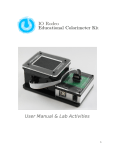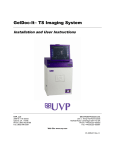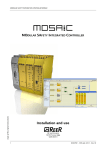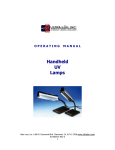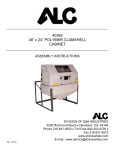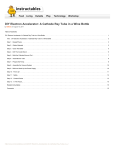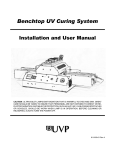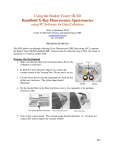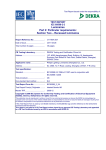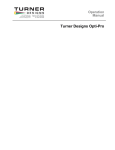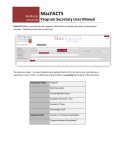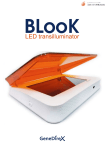Download UV Transilluminator User Manual
Transcript
UV Transilluminator User Manual Enclosure v 2.0 design files and build instructions Introduction Open source enclosure design files UV Transilluminator kit contents Acrylic enclosure parts Enclosure Hardware Assembly Instructions Step 1: Connect power Step 2: Enclosure base assembly Step 3: Enclosure top assembly Step 4: Attach the lid Viewing a gel with the UV Transilluminator Introduction UV-transilluminators are used in molecular biology labs to view DNA (or RNA) that has been separated by electrophoresis through an agarose gel. During or immediately after electrophoresis, the agarose gel is stained with a fluorescent dye which binds to nucleic acid. Exposing the stained gel to a UVB light source causes the DNA/dye to fluoresce and become visible. This technique is used wherever the researcher needs to be able to view their sample, for example sizing a PCR product, purifying DNA segment after a restriction enzyme digest, quantifying DNA or verifying RNA integrity after extraction. This User Manual describes how to make a narrowband UV-B transilluminator with a 7.5 x 7.5 cm window suitable for viewing and imaging DNA mini-gels. The kit contains all of the materials for making the transilluminator. Assembly time is approx. 30-60 mins. No additional tools required. Specifications: ● ● ● Enclosure: 19.8 cm long x 14.9 cm wide x 6.5 cm tall Viewing window: 7.5 cm x 7.5 cm Output wavelength: 305-315 nm with a peak at 311 nm. See attached spec sheet for more information on the UVB bulb Open source enclosure design files All of the enclosure designs files and BOM for the transilluminator are published by IO Rodeo on our bitbucket site under Open Source licenses. The design of this current version 2.0 of the UV Transilluminator is a slight modification of the UV Transilluminator v 1.0 described in a previous Instructable tutorial. The design has been modified slightly as described below: ● ● ● ● ● ● ● ● Viewing window increased to 7.5 cm x 7.5 cm (v 1.0 was 7 cm2) Design now includes a 9 cm2 UV transmissive diffuser which sits above the UV bulb Power entry switch now sits on the side of the box for easier access within a commercial Imaging Enclosure Acrylic material used to make the five parts of the enclosure base and sides has been changed to 1/8" black acrylic (v1.0 was 1/4" black acrylic) An additional part on the top has been included in this design to prevent any light leakage around the sides of the transilluminator glass New enclosure dimensions: 19.8 cm long x 14.9 cm wide x 6.5 cm tall Changes to the hardware (see the project on Bitbucket for the new BOM) Safety lid (clear or amber) has been increased to 10 cm x 10 cm (v1.0 was 8.2 cm x 10 cm) UV Transilluminator kit contents Each kit contains the following components: 1. 2. 3. 4. 5. 6. 7. 8. Acrylic enclosure parts and lid; Hardware (4 x standoffs, 24 x screws, 2 x hinges, 2 x wire connectors); Mini-screwdriver; Ballast with lampholder; UVB bulb; UV Transilluminator glass (8.25 cm square); Power connector; 6’ power cord Acrylic enclosure parts Each kit contains the following 16 laser cut acrylic parts. Five of the acrylic parts have been pre-tapped with threads for the appropriate screw size: ● ● ● ● ● Enclosure base: 2 x 8-32 holes for mounting ballast Enclosure top: 4 x 4-40 holes for mounting diffuser Enclosure side: 2 x 5-40 holes for mounting power connector UV transmissive cover: 4 x 8-32 holes for mounting hinges Hinged lid: 4 x 8-32 holes for mounting hinges Enclosure Base Enclosure Top Enclosure Sides Solacryl diffuser Power connector adapter Filter Holder #1 (1/4”) Filter Holder #2 (1/16”) UV transmissive cover Hinged lid (assembled in kit) Enclosure Hardware Qty Description Vendor Part # 4 Enclosure standoffs: mcmaster-carr 91780A174 mcmaster-carr 91249A123 mcmaster-carr 91249A108 mcmaster-carr 91249A102 mcmaster-carr 91249A108 mcmaster-carr 91772A188 8-32 machine screw, 3/16” long (silver) mcmaster-carr 91771A189 2 Hinges mcmaster-carr 1598A52 2 Twist-on wire connectors mcmaster-carr 7108K81 4-40 hex standoffs, 2” long 4 Enclosure top screws: 4-40 machine screw, 1” long (black) 4 Enclosure base screws: 4-40 machine screw, 3/8” long (black) 4 Diffuser screws: 4-40 machine screw, 3/16” long (black) 2 Power connector screws: 5-40 Thread, ½" long (silver) 2 Ballast screws: 8-32 Thread, 1/8" long (silver) 8 Hinge screws: Assembly Instructions Step 1: Connect power The ballast and power entry with switch in the kit are partially assembled - wires have already been soldered to the power connector and the lamp ballast as described in a previous Instructables 1 step. In the step you will mount these parts to the enclosure and use twist-on wire nut connectors to connect the power entry to the ballast. Parts: Enclosure base; ballast; 2 x ballast screws; enclosure side with cutout; power connector; power connector adapter; 2 x wire nuts; 2 x power connector screws. 1. Place the ballast onto the base plate and secure in place with the ballast screws. Tighten down with the screwdriver. Note the correct orientation of the ballast on the base plate below. 1 http://www.instructables.com/id/UV-Transilluminator/step3/Connect-AC-power-to-ballast/ 2. Thread the power connector through the power connector adapter and then through the enclosure side with the cutout. Secure in place with the power connector screws. Tighten down with the screwdriver. 3. Place the assembled part from the previous step onto the base plate in the orientation shown in the picture below. 4. The twist-on wire nut connectors will be used to connect the two neutral (white) and live (black) wires. a. Take the ends of the two black wires and line up the frayed ends. Twist the wires together. b. Insert the wire bundle into the connector and twist the connector clockwise until tight. It should fit tightly on the wires. Test by pulling on the connector to ensure if does not come off the wires. c. Repeat steps for the two white wires. Step 2: Enclosure base assembly Step 2 parts: Assembled part from Step 1; 3 x enclosure sides; 4 x enclosure standoffs; 4 x enclosure base screws; UV-B bulb. 1. Take one of the enclosure base screws and thread it through the corner holes on the enclosure base. On the opposite side of the enclosure, screw in one of the enclosure standoffs. Repeat for all 4 corners of the enclosure base. 2. Insert the UV-B bulb into the ballast and place the remaining enclosure sides into the slots in the enclosure base. Step 3: Enclosure top assembly The top part of the transilluminator has a total of 4 layers of acrylic which are used to mount the diffuser, the transilluminator glass and a UV transmissive protective cover. These top layers are secured in place with the four enclosure top screws and the standoffs. Step 3 parts: Assembled part from Step 2; diffuser, UV transilluminator glass, four remaining acrylic top plates (enclosure top, filter holders (2) and solacryl cover plate), diffuser screws, enclosure top screws. 1. Attach the diffuser to the ⅛” enclosure top using the diffuser screws. 2. Place the enclosure top onto the assembled enclosure from the previous step with the diffuser on the inside of the enclosure as shown in the image below. 3. Place filter holder # 1 onto the enclosure top. Next, place the transilluminator glass into the filter holder slot. 4. Next, place filter holder # 2 onto the enclosure followed by the UV-transmissive cover. In each corner screw in the four enclosure top screws. Tighten down with the screwdriver. Step 4: Attach the lid The kit comes with a clear1 acrylic lid for viewing gels. This lid does not pass UV light and is designed to completely cover the viewing window area. Step 4 parts: Assembled part from Step 3; hinges, hinge screws, acrylic lid. 1. Loosely attach the hinges to the top of the enclosure as shown using four of the hinge screws. Next, loosely attach the two hinges to the lid using the remaining screws. Once the lid is seated on the enclosure, tighten all of the screws. 1 Note, this lid can be swapped with an amber lid. When switching between lids, simply unscrew the hinges from the lid and replace it with the new lid. Viewing a gel with the UV Transilluminator Once you have your mini-gel prepared and stained, place it onto the transilluminator underneath the hinged lid as shown in the Images below. Always operate the UV-B bulb with the hinged lid closed. Switch on the transilluminator. At this point you should see your DNA bands. Safety Notes: 1. The gel above has been stained with ethidium bromide. As ethidium bromide is a toxic chemical with strict safety protocols, it is only recommended that you use this dye in a lab with established handling, storage and waste disposal procedures in place. Other users are strongly recommended to use the less toxic dyes such as SYBR-Safe instead, which can be handled and disposed of more safely. 2. The transilluminator does come with a safety lid for viewing the gel. However, when the lid is not in place, safety glasses must be worn when operating the UV-B bulb.

















